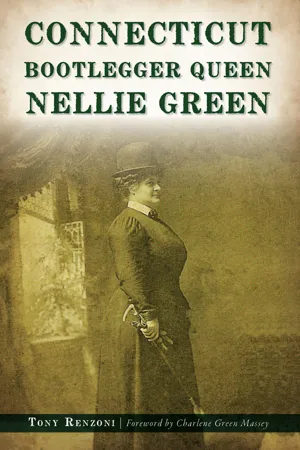
This is a test
- 179 pages
- English
- ePUB (mobile friendly)
- Available on iOS & Android
eBook - ePub
Connecticut Bootlegger Queen Nellie Green
Book details
Book preview
Table of contents
Citations
About This Book
Known as the "Queen of the Rumrunners on the East Coast, " Nellie Green led a captivating life full of bootlegging adventures. Nellie fearlessly stood up to all those who tried to stand in her way, receiving respect and financial support from many influential people. She built an underground empire in a business world dominated by men. Her rumrunners were men of intrigue who assumed aliases such as "Blackie, " "Wing" and "King Tut." Join author Tony Renzoni as he recounts the life and times of this legendary figure, set against the historical backdrop of the Prohibition era, the women's movement and the Roaring Twenties.
Frequently asked questions
At the moment all of our mobile-responsive ePub books are available to download via the app. Most of our PDFs are also available to download and we're working on making the final remaining ones downloadable now. Learn more here.
Both plans give you full access to the library and all of Perlego’s features. The only differences are the price and subscription period: With the annual plan you’ll save around 30% compared to 12 months on the monthly plan.
We are an online textbook subscription service, where you can get access to an entire online library for less than the price of a single book per month. With over 1 million books across 1000+ topics, we’ve got you covered! Learn more here.
Look out for the read-aloud symbol on your next book to see if you can listen to it. The read-aloud tool reads text aloud for you, highlighting the text as it is being read. You can pause it, speed it up and slow it down. Learn more here.
Yes, you can access Connecticut Bootlegger Queen Nellie Green by Tony Renzoni in PDF and/or ePUB format, as well as other popular books in History & North American History. We have over one million books available in our catalogue for you to explore.
Information
1
THE EARLY YEARS
I shall call her “Sugar”
—Charles Green
It was 2:00 a.m., and “Wing” St. Clair and his crew were preparing to set out from East Haven’s Farm River—destination Rum Row. For this mission, Wing chose to ride on one of his boss’s favorite boats, the Eda.
Anxious to move on, St. Clair yelled out to his crew, “C’mon men, let’s get going. We need to load up our boats and be back before the light of day.” As they had done on numerous occasions, Wing and his crew would venture out on the open seas to pick up their cargo from a waiting mothership stationed at the edge of international waters. They would then motor their speedy boats back to Farm River and deliver their precious cargo to the bootlegger who employed them. They were expert navigators, and they were fearless. They had to be. The men were rumrunners, and they were dealing with the dangerous transportation of illegal liquor during the historic era known as Prohibition. St. Clair knew it was important to travel in the wee hours of the morning to avoid the suspicious eyes of the U.S. Coast Guard. The crew knew they were able to outrun the best boats that the Coast Guard had to offer (as they had done many times), but why take further chances? Besides, their boss forbade them from carrying weapons during their missions, so setting out in the early morning made sense to them. These rumrunners knew it was a risky business, but to a man, they were more than up to the task. Their boss was tough but fair. Each man was treated as family, and they were all paid handsomely for their efforts. They always made an effort to deliver their goods in a safe and timely manner. It was important to them that they pleased their boss—the bootlegger who owned and managed the speakeasy hotel in East Haven. The bootlegger they worked for was a woman by the name of Nellie Green.
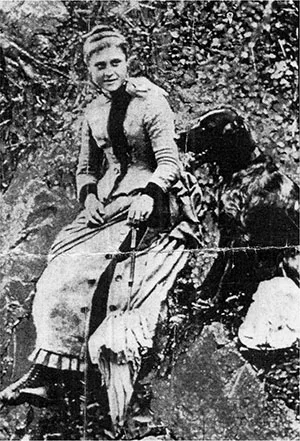
Ten-year-old “Sugar” digging for clams near Farm River.
Nellie Adeline Green was born in New Haven, Connecticut, on September 30, 1873, the only child of Charles Green and Ellen E. Glass.
Nellie’s grandfather John Green was the son of an English sea captain. He owned around 750 acres adjacent to the Farm River in East Haven, Connecticut. Nellie’s father, Charles Green, was born in May 1845. Charles and his father, John, enlisted in the Civil War and served in the Sixth Connecticut Regiment. Charles was only fifteen years old when he enlisted. Charles actually tried to enlist twice before but was turned down because of his age. But he was persistent, and on his third attempt, Charles was permitted to enlist along with his father, John. Captain Gerish, who accepted him, said of Charles, “He is so persistent he will make a good soldier, and I think his father and I together ought to be able to help keep him out of trouble.” But Charles was a restless and a mischievous boy. His father and commanding officer were not always successful in keeping him out of mischief, but the tricks he would play on others were innocent and harmless.
Charles served as a teenage drummer boy in the Civil War. He was involved in every battle that his regiment engaged in and never refused an assignment. When the bugle sounded for battle, he was always one of the first to take his position in the formation designated by the military officer. According to media reports, Charles was the first soldier from Connecticut to carry a flag of truce to the enemy. Carrying a flag of truce was a dangerous and courageous act. During the Civil War, soldiers would wave a white flag as a signal to the enemy to stop firing while fallen comrades were removed from a battlefield. While both sides agreed to the white flag, there was a great deal of apprehension and uncertainty that some enemy soldiers would not abide by this agreement.
After one heavily fought battle, young Charles went missing for three days and was given up for dead. On the following day, the fifteen-year-old marched into camp with two prisoners of war and received a hero’s welcome for his bravery.
During the war, Charles received multiple wounds in his wrist, knee and legs. During one mission, Charles received a wound that would have a lifelong effect. It was during that mission that Charles was struck in the forehead by a ricocheting Minié ball fired by an enemy rifle. The ball left a permanent indentation in his forehead. For this injury, Charles received extensive hospital treatment for three months. According to many people who knew him, the wound left an even deeper internal psychological scar that accounted for his hot temper and sometimes irrational behavior.
Nellie’s mother, Ellen Elizabeth Glass, was born in Glasgow, Scotland, in March 1837. She was a well-educated, sophisticated woman and, according to Nellie, “a great reader in general.” Charles and Ellen married in 1870. Like her husband, Nellie’s mother was not afraid to show her displeasure and anger when it was called for—especially toward men who drank too much and used foul language. This aversion to strong language and drunkenness was passed on to her daughter and caused many altercations between Nellie and intoxicated individuals who Nellie felt could cause her harm.
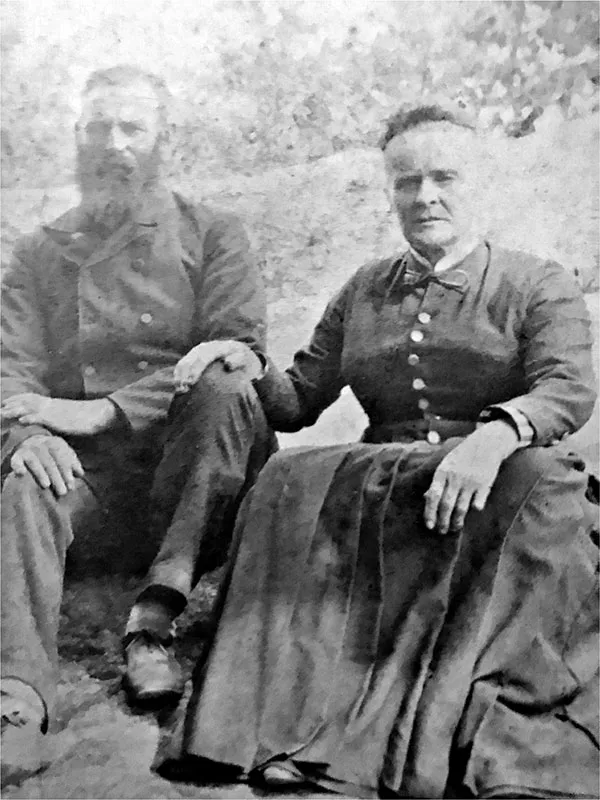
Nellie’s parents, Ellen (Glass) and Charles Green (looking closely at his forehead, you can see the bullet indentation from his Civil War injury).

Original Farm River bridge and Dyke House (in distance), 1880.
Around 1872, John Green built a place at the foot of Snake Hill in East Haven that became known as the Dyke House Inn. The Dyke House sat directly on the water, where the narrow Farm River divides Branford (Connecticut) and East Haven. For a time, Charles, Ellen and Nellie lived at 110 Prospect Road in East Haven when Nellie was eight years old. The family then moved into the Dyke House, where Nellie recalls growing up: “It had an open porch and served as a public place for clam bakes and the likes of that. My father became the owner and manager of the Dyke House Inn, which became lodging for folks travelin’ through. My grandfather sold booze at the Dyke House and people drove from New Haven and the Naugatuck Valley to buy the likker there.”
In 1874, soon after the Dyke House was constructed, John Green died. When Charles first heard that his wife had given birth to a girl, he walked into the room and showed his displeasure, having wanted a son. But upon seeing the baby, he changed his mind. Taking baby Nellie in his arms for the first time, Charles said, “I shall call her ‘Sugar.’” It was a nickname that stuck.
Even though he reluctantly accepted the fact that Nellie was a girl, Charles was determined to bring her up as a tomboy. When Sugar was only ten years old, Charles began giving her daily boxing lessons to be able to defend herself, in his words, “against all comers.” Nellie’s mother vehemently disapproved, but Charles ignored his wife’s opposition. Every day before breakfast, for six years, Charles gave her lessons on boxing and self-defense. As Nellie recalled, “He’d give me a whack, good and hard just to get me mad. My mother, who was a good and refined woman, said it was wrong what he was doin’, but she couldn’t do nawthin’ with him once he got goin’. I guess nobody could.”
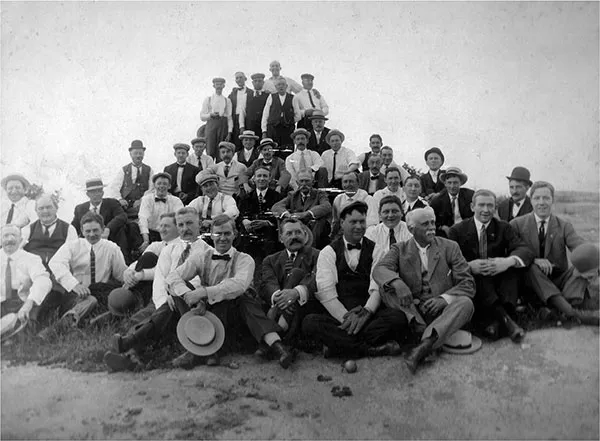
Get-together at the Dyke House Inn.
The lessons would last for six years, until Nellie was sixteen years old:
On my sixteenth birthday, my father approaches me with his boxing gloves darin’ me to hit him. My mother called out to him to stop it, sayin’ “Sugar’s a young lady now and you shouldn’t carry on like this anymore.” But it didn’t do no good. He gave me a good whack, and another and another, right and left. Then I got mad—that is what he was after—and I let him have it. It’s the God’s honest truth. I punched him all over the room until he gave up. We never put the gloves on after that. I guess he was more than satisfied that I could take care of myself because when he put the gloves away—and I noticed he was a-puffin’—he said, “Now don’t ever let me hear nawthin’ from nobody about my daughter.”
This was the world in which young Nellie Green was brought up—a physical, rough-and-tumble life. Nellie soon became adept at handling herself with her fists. For good or ill, Nellie would put her physical prowess to good use later in life.
Like her father, Nellie would use her fists and strength when she felt they were needed. Nellie recalled an incident when she was only ten years old, between her and a student at the Short Beach public school:
These kids began pushin’ me in the school hallway and I pushed ’em back. Then one of the kids throw’d water on me and that was it. I wrench’d the dipper away from the kid who done it and gave him a hard whack over the head with it. The teacher ran out of the classroom and said “What’s goin’ on here?” But when she seen me, she smiled, turned her head, and went back into the classroom. The teacher always—all the while I was there, till I was sixteen—made me the monitor while she was out. I was always the monitor.
Sugar was also assigned the task of monitoring the popular but illegal rooster prize fights that her father arranged. They were held in a big gray barn next to the Dyke House. Men from New Haven and other towns would show up, pay a small fee to her father and place their bets on these fighting roosters. (Sugar called them “chickens.”) These were no small events, as the barn could accommodate up to two hundred men.
They were tough, fightin’ chickens, trained and imported from Ireland. All the big shots—lawyers, bankers, businessmen, and the likes would sneak into the barn to gamble. If any ladies showed up, they’d get throw’d into the river. Honest truth. If the police showed up, it was my job to grab all the chickens and take them as far away as possible. In those days, the river came right up to the back of the barn. All I had to do was grab all the chickens, shove off, and row like hell down the river till things quieted down.”
At a very early age, Sugar learned to ride and race the horses that her family owned. When she was only ten years old, Sugar was assigned a number of tasks normally reserved for adults. One such task was to run errands to New Haven with the family’s horse and wagon.
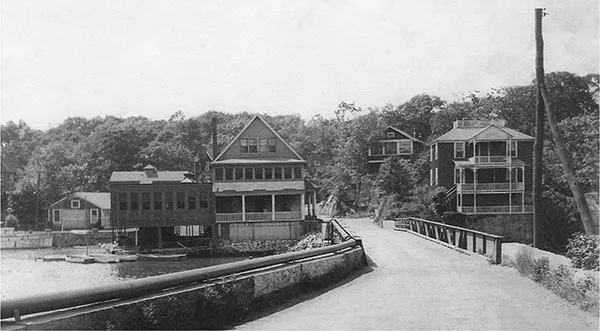
On extreme left of this photo is the barn where Sugar monitored the illegal rooster fights (view from Branford).
My father instructed me to ride to New Haven for the purchase of jugs or barrels of whiskey and kegs of beer, ten or fifteen cases of stuff. He would give me a list and tell me to hitch up the horse and go get it. And so, I would hitch up our horse Kit to the wagon and off I’d go. Kit was a sorrel mare, a female horse, and how she would race down the road. And I would not let anyone outrun ol’ Kit and me. If another horse and wagon came along and got close, I would put Kit into high gear. I used to sit right up there on the seat—there was no dashboard in front—and I’d hold her tight until the other horse came alongside. Then I would tap Kit with my foot and, oh boy how she would charge down the road. She’d make 3 minutes on that cobbled East Haven road, and she would keep it up. Kit would sweat but didn’t seem to tire out. I might ’ave killed her but you know how kids are. Because of the races, Papa’s beer would get all foamed up. He’d have to ice it to draw it off, and he’d yell the daylights out of me.
At age sixteen, Nellie felt obliged to leave school (when her mother began losing her sight) and lend a hand in the management of Dyke House. Nellie took control of the neglected family household. Through her own self-discipline and strict attention to finances, Nellie converted the Dyke House Inn into a productive enterprise.
As a child, she helped out by tending the nearby drawbridge that crossed the Farm River into Branford and also delivered lunches to the laborers upstream at the Trap Rock Quarry. She also became more active in the finances and management end of the business.
Nellie’s mother’s attitude toward abusive language and intoxication was deeply ingrained in her daughter’s mind. Throughout her teenage years and even later in life, Nellie was involved in numerous confrontations involving intoxicated men using abusive language who made unwanted advances. In a July 1892 incident covered by local news, eighteen-year-old Nellie was approached by an intoxicated young man who made advances toward her. The two engaged in a bloody fistfight, and the man pulled out a knife and stabbed Nellie in the stomach. For this incident, the young man was fined and sentenced to two months in jail.
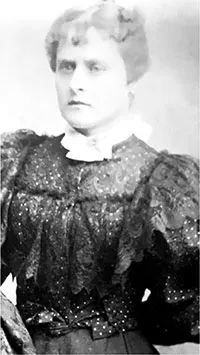
Nellie Green.
Another altercation that was also covered by the printed media, but on a wider scale, occurred in May 1902. After this incident, twenty-eight-year-old Nellie and another individual (a Mr. Brown) accused each other of assault, with the matter ending up in court. Nellie knew this person quite well. When she was ten years old, she witnessed a fight between Brown and her father. During that altercation, Brown stabbed her father with a knife. Afterward, Charles Green was bedridden for three months. Brown did not fare much better—he was beaten to the ground quite severely by Green.
Nellie described her later confrontation with Brown to the jury this way:
Mr. Brown came into the Hotel stinkin’ drunk and began to use bad language against me. I told him to shut up or I would beat him along. He then went out to the barn and started drinking whiskey again. I followed him to the barn because I didn’t want anything stolen. I told Brown to get out and then he reached in his pocket as if to get a knife. I told him he couldn’t stab me in the back like he did my father. Then I kicked him up the hill. After he threw a stone at me, I picked up my stick. I hit him with my stick several times, dro...
Table of contents
- Front Cover
- Half Title
- Title Page
- Copyright
- Contents
- Foreword, by Charlene Green Massey
- Acknowledgements
- Introduction
- 1. The Early Years
- 2. Nellie’s Singing and Equestrian Careers
- 3. Tragedy Strikes
- 4. Nellie’s Heroics and the Bridge
- 5. The Prohibition Act
- 6. Nellie Green: The Prohibition Years
- 7. The Sinking of the Sparkle—A “James Bond” Adventure”
- 8. Prohibition in Connecticut
- 9. The Real McCoy and the Prohibition Pirates
- 10. Women Bootleggers
- 11. The Flapper Phenomenon and “Lipstick”
- 12. Hotel Talmadge
- 13. Nellie’s Viewpoint
- Appendix A. Nicknames of Rumrunners, Prohibition and More
- Appendix B. Flapper Slang Language
- Bibliography
- About the Author